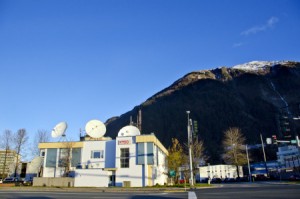Alaska’s public broadcasters dodged a bullet when the legislature’s regular session ended Monday.
House and Senate negotiators decided on a 23.5 percent budget reduction. A proposed cut more than twice that size could have forced at least five stations off the air. It also would have dramatically reduced programming at other outlets.

Gov. Bill Walker on Tuesday released a new operating budget for lawmakers to consider in a special session he called. But it didn’t include any change in public radio or TV funding.
Officials say cutting almost a quarter of stations’ state appropriations will have significant impacts.
Tom Abbott, general manager of Petersburg’s KFSK-FM, says he expects to maintain local staff and programming.
“We’re going to stick with our mission, [and] that first and foremost is our local service. That will direct us toward loss of network programing. And that, of course, will be noticeable, it will be significant, it will be some favorite programs,” he says.
Those include “Prairie Home Companion” and “This American Life.” He says National Public Radio shows, such as “All Things Considered,” will continue.
Other stations throughout Alaska face similar challenges. The state helps fund about 25 radio and three TV operations.
Stations also receive financial support through memberships, underwriting, fund-raisers and grants.
KFSK’s Abbott says he hopes to raise more money locally. But he worries that could be difficult when popular shows are cut.
“I would hope that that is minimal. And that people will understand the situation that we’re in and that keeping the local system intact is our priority. Network programming can come back. Personnel can’t, necessarily,” he says.
Abbott says his station will hold community meetings to discuss its budget plans.
At one point, the Senate proposed a 60 percent funding cut, which would have ended local service at some smaller stations.
Alaska Public Broadcasting Commission member Brenda Hewitt, in an earlier interview, said those stations provide an essential service.
“We could listen to national news and we could know what was happening in the nation. But you wouldn’t know what’s happening locally. Or if you cut out state broadcasting you don’t know what’s happening in the state,” she said.
The legislature’s final budget eliminated earlier language directing state money toward smaller, rural stations
Ed Schoenfeld is Regional News Director for CoastAlaska, a consortium of public radio stations in Ketchikan, Juneau, Sitka, Petersburg and Wrangell.
He primarily covers Southeast Alaska regional topics, including the state ferry system, transboundary mining, the Tongass National Forest and Native corporations and issues.
He has also worked as a manager, editor and reporter for the Juneau Empire newspaper and Juneau public radio station KTOO. He’s also reported for commercial station KINY in Juneau and public stations KPFA in Berkley, WYSO in Yellow Springs, Ohio, and WUHY in Philadelphia. He’s lived in Alaska since 1979 and is a contributor to Alaska Public Radio Network newscasts, the Northwest (Public Radio) News Network and National Native News. He is a board member of the Alaska Press Club. Originally from Cleveland, Ohio, he lives in Douglas.




